
* By the spring of 1942, continued improvement of the B-17 and combat experience finally produced the first version of the Fortress that was truly ready for war. The B-17F and the similar B-17G were built in large quantities and bore the brunt of the daylight bombing campaign against Hitler's Germany.
* More than 512 B-17Es were ordered by the USAAF, but detail changes in Fortress design driven by field experience accumulated to the point where the aircraft became sufficiently different to be given a new designation, "B-17F". The first B-17F rolled off the production line in April 1942.
The B-17F was hard to distinguish from a B-17E. The major visible external changes were a longer single-piece conical Plexiglas plastic nose with a flat bomb-aiming panel; wider Hamilton Standard paddle-blade propellers; and revised engine cowlings. However, the B-17F featured hundreds of internal changes. The most significant were new fuel tanks added in the outer wing. These were referred to as "Tokyo tanks" and provided an additional 4,165 liters (1,100 US gallons) of fuel. They extended range to 6,800 kilometers (4,220 miles) -- though fumes escaping from the tanks proved an explosive menace, and led to the adoption of a venting system.
Other important changes included self-sealing oil tanks; heavier landing gear to handle the increased weight; and external bomb racks under the inner wings. The B-17's limited bomb capacity had been the subject of much legitimate criticism, and the bomb racks were intended to correct that error by increasing the bomb load from the typical 1.8 tonnes (4,000 pounds) to up to 4.35 tonnes (9,600 pounds). Later modifications of the external bomb rack scheme increased the maximum bombload to 9.4 tonnes (20,800 pounds), but the external racks proved futile: they were rarely used except for special missions, since external loads led to significant performance penalties.
Many B-17Es had been modified in the field to accommodate one or two 12.7-millimeter M2 Brownings firing out each side of the nose through staggered Plexiglas panels to counter frontal attack. B-17Fs included the nose guns as "standard", more or less, though there were many variations on gun fit. Eventually, "cheek" windows that provided a limited forward field of fire were fitted, with the left window staggered ahead of the right to keep the two guns out of each other's way in the cramped nose.
In fact, the B-17F received a long series of small modifications with successive production blocks. One of the significant improvements added later in production were uprated GR-1820-97 Cyclone engines. In conjunction with the paddle propellers, the new engines did much to preserve the Fortress's performance, even with the creeping weight increases.
The B-17F was put into large-scale production. The USAAF wanted as many B-17Fs as they could get their hands on, and contracted for additional manufacture of the bomber from Lockheed's Vega plant in Burbank, California, and from Douglas's plant in Long Beach, California. This scheme was known as the "BVD (Boeing-Vega-Douglas)" pool. Boeing-built B-17Fs were designated as "B-17F-BO"; Vega-built aircraft as "B-17F-VE"; and Douglas-built aircraft as "B-17F-DL". B-17Fs were also designated by an additional block number suffix, such as "B-17F-10-VE", but different block number ranges were assigned to the different manufacturers, making the block number scheme too confusing to be worth describing in detail here. Modification centers were also established stateside and overseas to add improvements as they were devised or as required by local circumstances.
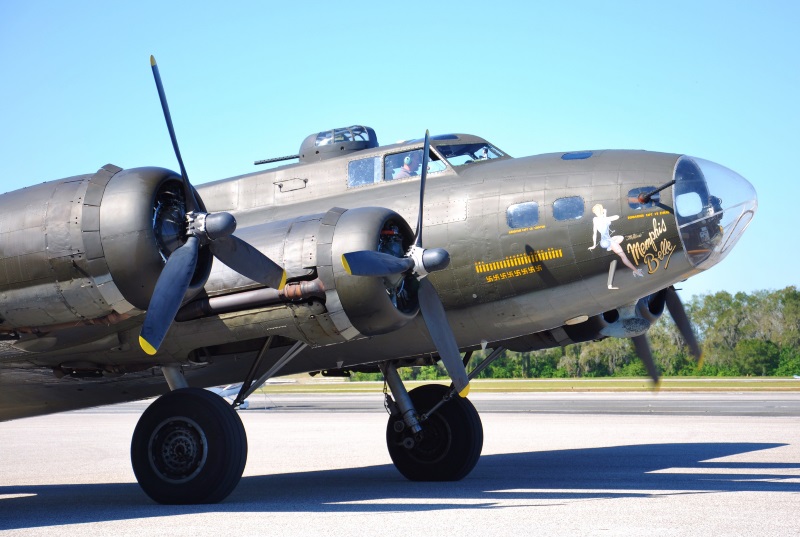
* The B-17F was primarily allocated to the European theatre. B-17Es and B-17Fs arrived in the UK in the summer of 1942 to provide the backbone for precision daylight raids over Europe, though the B-17Es would be relegated to training duties as the number of B-17Fs ramped up. On 17 August 1942, the 8th Air Force performed the first strike of the USAAF's daylight bombing campaign by attacking railyards at Rouen, France, with 12 Fortresses under heavy escort by RAF Spitfires. Significant damage was inflicted on the target, and only two bombers were damaged by flak. Further raids into France went easily as well, but on 6 September the Luftwaffe decided to fight back, and shot down two out of a formation of 20 Fortresses. The tempo of the battle was beginning to pick up.
In November, two bomb groups were diverted to the 12th Air Force to support the invasion of North Africa. This depleted Fortress units based in England, but their numbers were quickly built back up. However, raids conducted through the end of the year obtained poor results, characterized by confused air operations and inaccurate bombing. The freeze-up problems that had plagued the RAF's Fortress Is came back -- though such difficulties were eventually brought under control by procedures designed to keep aircraft dry before take-off.
The USAAF spent much of this time refining tactics and getting organized, particularly under the inspiration of Colonel Curtis LeMay, commander of the 305th Bomb Group. By December 1942, the USAAF had defined an 18-plane bomb group formation, in which the bombers were organized in six "vics", with one in the lead, two trailing to the right, and three trailing to the left. The bombers were staggered vertically from the top aircraft at right to the bottom aircraft at left. This formation helped obtain tight bomb patterns while optimizing defensive firepower. The lead bomber sighted for the formation. Earlier doctrine allowed bombers to target and drop their bombs individually, but that disrupted the formation and led to mid-air collisions. Formation structure would be enhanced through the war, ultimately combining several formations into a "combat box" that stretched through the sky.
* Through 1942, the Fortress raids had been restricted to France and the Low Countries, with the bomber formations generally being accompanied by fighter escorts. On 21 January 1943, 67 Fortresses raided a German target for the first time in an attack on the U-boat construction yards at Vegesack. The target was socked in and the Fortresses attacked Wilhelmshaven, their secondary target, instead. Results were poor, but at least casualties were light, with only three Fortresses shot down. Luftwaffe pilots were a bit confused in dealing with the big and heavily-armed Fortresses and didn't press their attacks. They wouldn't remain timid for long.
Bad weather interfered with raids over the next few months, while the defenders refined their tactics. On 17 April 1943, 115 Fortresses attacked the Focke-Wulf plant at Bremen. 16 of the aircraft were shot down, and 48 of the rest were damaged to some degree. That was a shocking loss rate, though Fortress gunners claimed hundreds of Luftwaffe fighters destroyed. The numbers were fantasies: despite USAAF attempts to be strict in accounting for such kills, the necessary confusion of an air battle led to inflated claims that were almost a factor of ten greater than reality. The gunners were claiming about five German fighters for every Fortress shot down; in reality, the ratio was more like one German fighter for every two Fortresses lost.
It is still hard to believe that the Luftwaffe found the Fortress, with its heavy armament, an easy kill. The big bomber could take a lot of punishment, and if its blazing turrets weren't all that likely to score hits, they certainly made sure that a German pilot didn't waste any time in making a pass, and then getting out of range again.
* Few B-17Fs saw service in the Pacific theater. During the early part of the war in the Pacific, the USAAF had realized that high-altitude strategic bombing was not particularly useful in the war against the Japanese. The targets were generally naval vessels or small ground installations, not big cities, military bases, or industrial complexes; low-level medium bombers were much more effective.
Although the Air Corps had spent considerable effort on the concept of high-altitude bomb attacks against ships, in practice it was a joke. Properly recognizing a moving ship from high altitude, much less hitting it, was extremely difficult. During the battle of Midway in June 1942, 19 Fortresses operating from Midway Island performed 80 sorties to attack Japanese shipping. They reported good results, but in fact they hit nothing. That was fortunate, because one of the targets was a US submarine, which was mistaken for a cruiser and reported as sunk after it dived.
By early 1943, the Japanese were being pressed back and bombing attacks began on their large ground installations. High-altitude bombing became useful, but the B-24 Liberator had longer range, making it more useful for the far-flung Pacific theater, as well as greater bombload. The Fortress effectively disappeared from the Pacific during 1943.
* The Fortress units that had been diverted from the 8th Air Force in England to the 12th Air Force in Africa began operations from Algeria on 16 November 1942. They were joined the following spring by additional Fortress bomber groups. After the collapse of Axis resistance in Africa, they performed raids on Sicily, preparatory to the invasion of the island. Air operations for the 12th were easier than those for the 8th. The weather was generally sunny, the ranges were shorter and fighter escorts were the norm, and Axis air and anti-aircraft defenses were weaker.
After the invasion of Italy, bases became available on the Italian mainland for bomber operations, and the new 15th Air Force was organized to fly out of them. The 15th primarily operated B-24 Liberators and its strength in Fortresses never amounted to more than a fifth of the B-17s operated by the 8th. The 15th Air Force was primarily focused on attacks against targets in Southern Europe, particularly the Ploesti oil fields in Romania. Unfortunately, the B-24 was more vulnerable to combat damage than the Fortress, and the B-17 was preferred more often than not by bomber crews. Pilots particularly liked the B-17 because it was so easy to fly, while the B-24 was noted for the tiring heaviness of its controls.
* 3,405 B-17Fs were completed in all. 2,300 were built by Boeing, Lockheed-Vega built 500, and Douglas built 605.
There were a number of special conversions of the B-17F. The "F-9" series were strategic reconnaissance aircraft, fitted with a varying arrangement of from 6 to 10 cameras. Some 51 B-17F bombers were converted to F-9, F-9A, or F-9B reconnaissance machines.
As with the B-17E, a few B-17Fs were converted to transport configurations. The "YC-108B" was another VIP transport in the style of Douglas MacArthur's BATAAN, and the "XC-108B" was fitted as a tanker and used to ferry fuel over the Himalayas on the "Hump" route from India to China. Many other Fortresses were more informally stripped down and used as transports during the war.
19 B-17Fs were supplied to the RAF Coastal Command, which designated them "Fortress IIs", as mentioned earlier. They were used with their Fortress IIA (B-17E) predecessors for antisubmarine patrol, with the designation of "Fortress GR.IIA" in this role. They were armed with depth charges, and many were later fitted with longwave "Mark III ASV (Anti-Surface Vessel)" radar, with "stickleback" aerials along the fuselage spine and Yagi antennas underneath the wings. The Fortress Mark II/IIAs proved capable at their role and were credited with sinking 13 U-boats. They were eventually replaced in this role by Liberators and Sunderlands, and were then put into service for weather reconnaissance, where their high-altitude capabilities were a definite asset.
In early 1944, 14 B-17Fs were transferred to the RAF from the USAAF 8th Air Force to be converted into electronic warfare platforms of various types. They were designated "Fortress II(SD)", where "SD" stood for "Special Duty", and used as flight trainers for electronic warfare variants of the later B-17G, or "Fortress III" as it was called in RAF hands.
In November 1943, the Canadians acquired three B-17Es and three B-17Fs that had been in service with American training units. These six aircraft were used for transatlantic mail service.
BACK_TO_TOP* Even as the Fortress was entering combat over Europe, the USAAF was considering more improvements to the type. Although the B-17 was fitted with a series of improved versions of the Wright Cyclone radial engine, further effort on the Cyclone was obviously facing diminishing returns. In the summer of 1942, the USAAF asked Lockheed-Vega to modify a B-17E to use the Allison V-1710-89 engine. This was a supercharged 12-cylinder liquid-cooled inline engine, used in the Lockheed P-38 Lightning fighter. The Allison engine provided 1,065 kW (1,425 HP) at altitude, substantially more than the Cyclone.
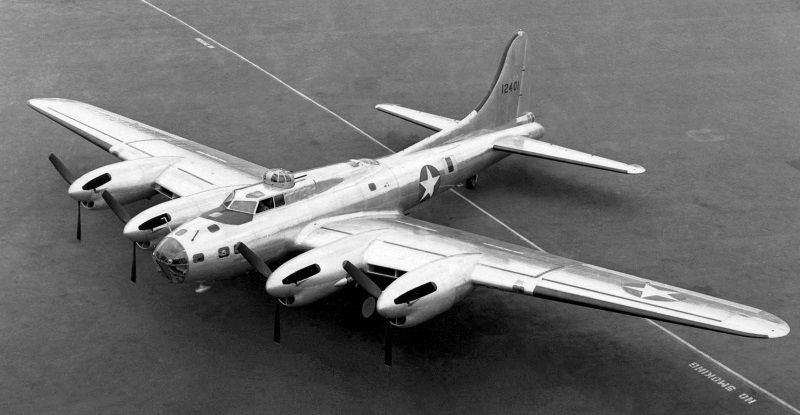
The new aircraft was designated "XB-38". Work went slowly and the Allison-powered Fortress did not fly until 19 May 1943. The XB-38 featured long-nosed nacelles for the Allisons reminiscent of those on the P-38, with the cooling radiators placed in the wing leading edge. The XB-38 had a top speed of 525 KPH (325 MPH), but a lower service ceiling than Cyclone-powered Fortresses. The XB-38 only flew for about ten hours. On 16 June, one of the engines caught on fire and the aircraft crashed, the crew successfully bailing out. Two other XB-38s were planned, but the USAAF decided that the benefits obtained with the Allisons were not sufficient to justify diverting delivery of the engines from the P-38 and other fighter production. The XB-38 program was canceled in August 1943.
* The need for long-range escorts to protect Fortress formations had been a concern even before the 8th Air Force began its raids over Germany, and in April 1942 the USAAF initiated studies into a "convoy protector" or "escort Fortress" that would carry increased armament and armor to deal with attacking fighters.
The initial Fortress "gunship", the "XB-40", was modified from a Boeing-built B-17F by Lockheed-Vega and first flew in September 1942. The XB-40 bristled with 12.7-millimeter machine guns. The Sperry ball turret and the Bendix ball turret were retained from the B-17F, while the waist gun positions were increased to two guns each with power boost, and the twin-gun tail position was given power boost as well. A second Bendix turret was added over the radioman's position, and a new Bendix "chin" turret was fitted under the nose, with the bombardier controlling it from a sight in the Plexiglas nose. Armor was added for engine and crew protection. Experience showed that the waist gunners tended to get in each other's way, which could be dangerous since it could lead to fouling their oxygen lines, and so the waist positions were "staggered" to give the gunners more room. The XB-40 could carry about 11,000 rounds of ammunition, about three times that of a regular B-17F.
Flight tests at Wright Field suggested that the escort Fortress idea had promise, and so 23 "YB-40s" were ordered, though only 19 were actually delivered. They were modified from Vega-produced B-17Fs by the Douglas plant in Tulsa, with the first rolled out in February 1943. YB-40s arrived in England in April 1943 for combat evaluation. The results did not meet expectations. There were bugs and shoddy workmanship, but most significantly the YB-40 was simply too heavy. It could follow bomber formations well enough until they dropped their bombs, but then the bombers could take advantage of increased speed and altitude bought by the reduced weight. The YB-40 was still loaded down with guns and ammunition, and couldn't keep up with the formations on the way home. The program was canceled in July 1943.
Some YB-40s were sent back stateside and used for gunnery training as "TB-40s". Although the YB-40 was a failure, operational commanders indicated that the Bendix chin turret and the staggered waist gun positions were good ideas that should be incorporated into B-17 production.
BACK_TO_TOP* These good ideas appeared in the next and definitive version of the Fortress, the "B-17G". The B-17G was basically a B-17F with the Bendix chin turret and the staggered waist gun windows. Eventually, these waist gun windows would be enclosed by Plexiglas panels. Incidentally, it appears a few very late-production Douglas-built B-17Fs also had the chin turret, though it is unclear if they had the staggered gun positions as well.
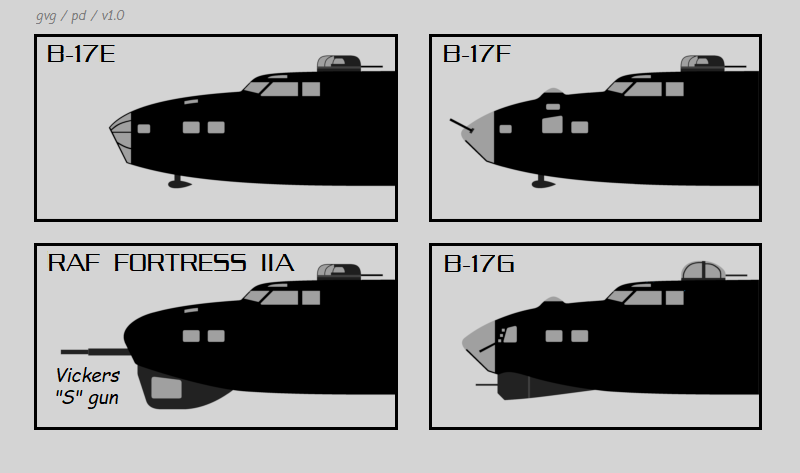
Other changes were implemented as B-17Gs rolled off the production lines. The useless upward-firing gun in the radio room was deleted. A new tail gun position was designed, featuring power-boosted guns featuring a greater range of traverse; a better reflector gunsight replacing the previous ring-and-bead sight; and a larger space for the gunner, with bigger windows, that offered improved visibility and extended back from the tailfin. This new gun position was called the "Cheyenne Tail", since it was designed by the United Air Lines field modification center at Cheyenne, Wyoming. It was retrofitted to many earlier B-17s at field modification centers.
The Sperry upper turret was also changed during production to a similar Bendix model that had a taller top; the new turret was more agile and had better field of view. Finally, the hydraulically-operated turbocharger regulators used on earlier Fortresses were replaced by electrically-operated regulators, then by an entirely new and improved turbocharger that provided greater reliability and performance.
___________________________________________________________________
BOEING B-17G FLYING FORTRESS:
___________________________________________________________________
wingspan:
31.6 meters (103 feet 9 inches)
wing area:
131.92 sq_meters (1,420 sq_feet)
length:
22.8 meters (74 feet 9 inches)
height:
5.85 meters (19 feet 2 inches)
empty weight:
16,390 kilograms (36,135 pounds)
MTO weight:
29,710 kilograms (65,500 pounds)
maximum speed:
475 KPH (295 MPH / 255 KT)
service ceiling:
11,000 meters (36,000 feet)
operational radius:
1,290 kilometers (800 MI / 695 NMI)
___________________________________________________________________
* The failure of the YB-40 highlighted the increasingly desperate need for an adequate long-range fighter escort. Spitfires and USAAF P-47 Thunderbolts didn't have the range. Although the P-38 Lightning had the endurance to accompany the Fortress on long-range raids, it was not well suited to high-altitude combat and was not adequate for the escort task.
Fortress raids over Germany into that summer continued to grow in size. 235 Fortresses attacked a rubber plant at Huls in the Ruhr on 22 June 1943. Due to diversionary tactics, their losses were relatively light and results of the raid were satisfactory. On 17 August 1943, the anniversary of the first Fortress raid, 147 Fortresses attacked the Messerschmitt plant at Regensburg, followed by a raid by 230 Fortresses on the ball-bearing plant at Schweinfurt. The result was a disaster, with 60 B-17s lost in combat. The first wave went on to land in Tunisia after its attack, and of those that landed there, 55 were too badly damaged to return to England. Bombing results were equally dismal. Fortress gunners were credited with destroying 148 German fighters; in reality, they only shot down 25.
The 8th Air Force recuperated for a few weeks, rebuilding strength with the new B-17Gs arriving from the US; then, on 6 September 1943, 338 Fortresses attacked Stuttgart, or at least tried to. The target was completely socked in, and the Luftwaffe savaged the raiders. 30 Fortresses were lost, while no significant damage was done to the target.
To address the weather problems, the USAAF was acquiring help in the form of British electronic wizardry that would allow bombing even when a target was socked in. The gear included a navigation system named "Gee" based on timing signals from transmitters in the UK; a precision bombing system named "Oboe" that used radars in the UK to track a bomber and indicate when it should drop its bombs; and a ground mapping radar named "H2S" carried on a bomber, later upgraded to the slightly better American variant known as "H2X".
Gee and Oboe were good systems -- Oboe was about as accurate as using an optical bombsight -- but limited in range. H2S/H2X didn't have any range limitation since it was carried on the bombers themselves; it was a crude system by modern standards, only really able to identify targets with major distinctive landscape features, such as river bends and confluences or lakes, but it was much better than nothing. H2S was originally fitted in a bathtub in the nose of the Fortress, to be replaced by with H2X in a retractable radome in the same position, with the H2X finally moved to replace the ball turret installation. On 27 September, the USAAF conducted a raid on Emden, with some of the formations led by Fortresses equipped with H2S. These "pathfinders" dropped smoke markers on the target, with the smoke plumes serving as aiming points. Eventually, all Fortress bomber groups would have their own radar-equipped pathfinder B-17s using H2X or improved electronic-bombing systems.
By this time, a Fortress was only expected to last 11 missions before being destroyed. This meant that the statistical chances of a B-17 crewman surviving a 25-mission tour were poor. Some improvements in survivability were being obtained, however, with new technology such as "Carpet", an electronic box to jam German anti-aircraft control radars.
These improvements weren't enough. On 14 October 1943, the USAAF raided Schweinfurt again, using 291 Fortresses. By this time, the Luftwaffe had refined their tactics to a peak of efficiency, and the defense was intense, large scale, and well planned. The Luftwaffe used stubby 21-centimeter (8.25-inch) rockets to blast apart the B-17 formations, and then attacked Fortresses individually without having to fly through a hornet's nest of massed machine guns. 60 B-17s were shot down, five more crashed in England, and 12 were junked after landing, for a total loss of 77 aircraft. Another 121 received repairable damage. 14 October became known as "Black Thursday". Unescorted daylight precision bombing was simply unworkable, and the USAAF was forced to abandon serious attacks on Germany until long-range escorts were available.
They didn't have too long to wait. By December, Merlin-powered P-51 Mustangs were arriving in England, and with drop tanks these excellent fighters could accompany the Fortresses deep into Germany. Also in December 1943, the USAAF began the practice of dispensing "chaff", or strips of aluminum foil, to confuse German radars. Although the Germans would develop some counter-countermeasures, chaff was still an effective defensive measure. Chaff was dispensed by Fortress crews through chutes, or simply issued to the waist gunners in packets for them to throw out the waist gun windows.
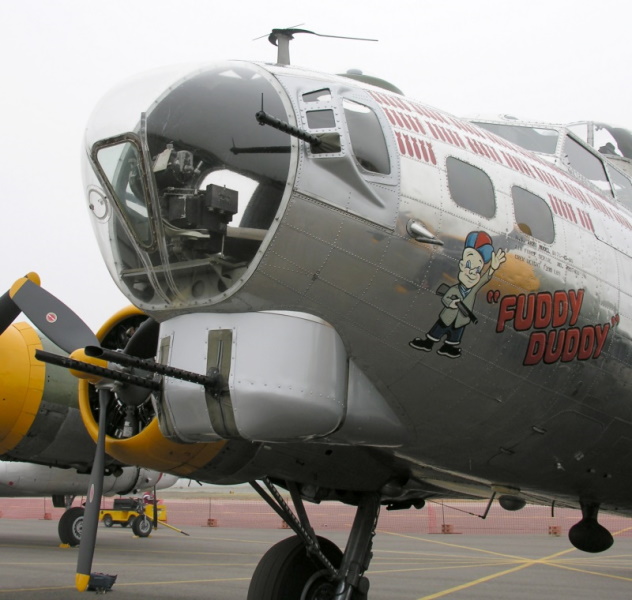
8th Air Force activity remained relatively low for the rest of the year as the weather deteriorated, though in January 1944 the 8th performed a series of raids on V-bomb sites in the French Pas-de-Calais. In late February 1944, however, the Fortresses came back to Germany with a vengeance and with escorts. During the USAAF's "Big Week", from 20 to 25 February, the bombers raided aircraft manufacturing plants all over Germany. The raids seriously disrupted German aircraft production, and in particular delayed German plans for the manufacture of their new jet aircraft. 226 B-17s and B-24s were lost, which was severe by absolute standards but low in comparison with the 3,800 sorties performed. 28 fighter escorts were lost.
On 4 March, the USAAF went to attack Berlin for the first time, the primary motivation being to draw up Luftwaffe defenders so they could be destroyed. Bad weather intervened and a recall order was sent, but one wing of 29 B-17s failed to get the word and continued. Part of the escort force stayed with them to protect them. The B-17s hit Berlin using a radar pathfinder and were attacked by the Luftwaffe on the way home. 23 Mustangs were lost, but only five Fortresses.
On 6 March, the USAAF tried to hit Berlin again with a force of 561 B-17s and 249 B-24s. They were protected by Thunderbolts, Lightnings, and Mustangs working in relays. The result was something of a fiasco. The bomber streams became disorganized, ran into intense flak and fighter opposition, with 56 B-17s and 17 other USAAF aircraft being lost. This mission was characterized by some of the wildest, most frantic air battles of the war.
The USAAF refined their tactics and went back to Berlin three more times in March. Later that spring, the focus shifted to attacks on communications centers and in particular oil production, with 935 8th Air Force bombers attacking oil plants on 12 May. To the south, the Italy-based 15th Air Force was hitting Ploesti in Romania. German fuel production fell to a trickle, and by the end of summer 1944, the Luftwaffe was hard-pressed to get fighters in the air.
By October, the Luftwaffe had lost too many experienced pilots in air combat, and the lack of fuel meant that training new ones was increasingly difficult. The Germans increasingly were forced to rely more heavily on anti-aircraft guns for defense. Flak was less effective than fighters in destroying bombers, but bomber crews often preferred to deal with fighters, since they could at least shoot back at them. In some cases, guns and armor were removed from combat B-17s and replaced with "flak curtains", which were laminated plates sewn into canvas to stop low-velocity shrapnel.
USAAF bomber losses fell off to the point where a tour of duty was increased to 30 and then to 35 missions. Raids on Germany grew in intensity. On 22 February 1945, for example, 1,411 bombers hit communications centers all over Germany, bombing from relatively low altitudes of about 3 kilometers (10,000 feet). Even though the Germans were now flying their new Messerschmitt Me 262 jet fighter against the USAAF, only one bomber was lost in air combat on that day, while four others were brought down by flak.
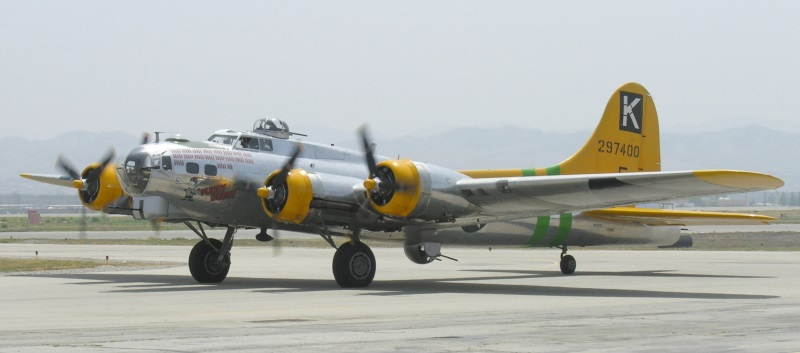
The 8th Air Force raided Berlin for the last time on 18 March 1945, using 1,327 heavy bombers. Although the Luftwaffe flew up to 50 Me 262s against them, Allied air superiority was almost absolute, and only eight bombers were lost to the fighters. Flak shot down 16 more bombers, and damaged 16 others that were forced to land in Russian-held territory. On 16 April 1945, the USAAF high command decreed that there were no more strategic targets worth bombing, and the air war shifted to tactical support. The 8th Air Force performed its last raid of the war on 15 April 1945 on the Skoda munitions plant in Pilsen.
* More B-17Gs were built than all other models combined, a total of 8,680, out of 12,731 Fortresses built of all types. 4,035 B-17Gs were built by Boeing, while 2,395 were built by Douglas and 2,250 by Lockheed-Vega. The very last B-17 was delivered from the Lockheed-Vega plant on 29 July 1945. 10 B-17Gs were converted to photo-reconnaissance configuration as "F-9Cs". They would be redesignated "FB-17G" and then "RB-17G" after the war.
Leveraging off British technology, 12 B-17Gs were converted to the air-sea rescue (ASR) role as the "B-17H". There were variations in the configuration of this type, but most commonly they had all armament removed, the chin turret replaced by search radar, and a parachutable Higgins A-1 lifeboat strapped under the fuselage. The Higgins boat was 8.2 meters (17 feet) long, weighed 1,360 kilograms (3,000 pounds), and had twin engines plus survival kit. It would be dropped on triple parachutes, and on hitting the water would toss out lines on small rockets to help those in the water.
Development of the B-17H began in 1943, but a lack of available bombers delayed service introduction until March 1945. Several B-17Hs were sent to the Pacific during the last months of the war, and also performed ASR duties during the Korean conflict. These aircraft were redesignated "SB-17G" after WW II. The US Coast Guard received 30 B-17Gs upgraded to this configuration after the war, and designated them "PB-1G".
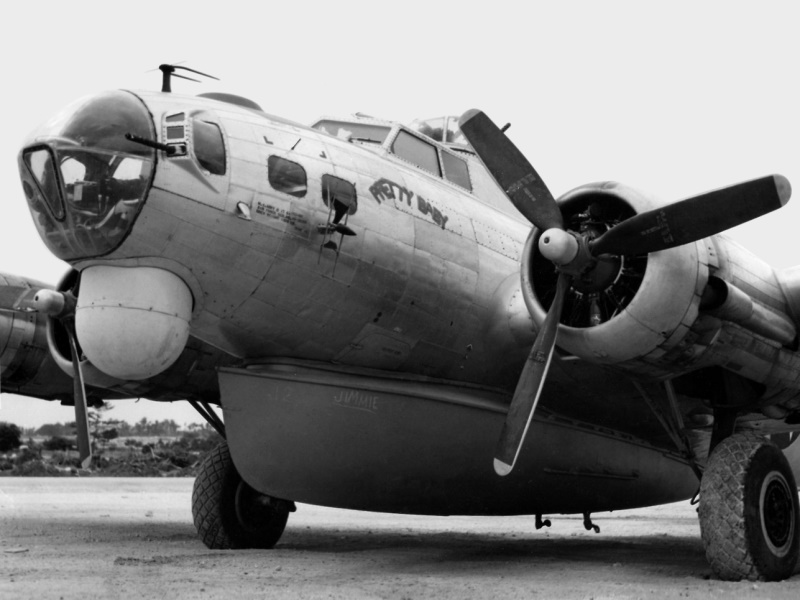
The US Navy also operated 31 B-17Gs, including one B-17F that had been upgraded to B-17G standards. These were used for anti-submarine patrol as the "PB-1". There were variations in configuration, but after the war they were generally fitted with AN/APS-20 radar in a large radome under the bomb bay, to be used for airborne early warning as the "PB-1W".
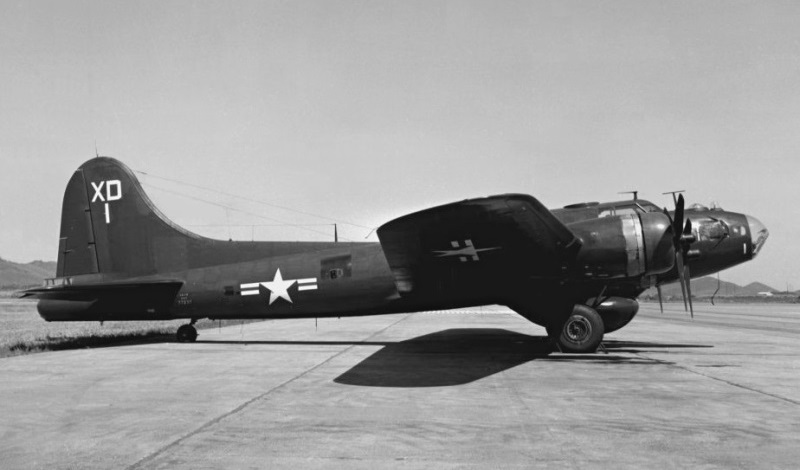
85 B-17Gs ended up in RAF hands, and as mentioned earlier were mostly used for electronics warfare missions as the "Fortress III(SD)". The electronics gear fitted varied considerably, but a baseline configuration included a Monica Mark IIIA tail-warning receiver; a Jostly Mark IV VHF jammer; four Airborne Grocer air-intercept jammers; Gee and LORAN navigation systems; and H2S radar installed in a fairing that replaced the chin turret. By the terms of Lend-Lease, at the end of the war the British had to return all gear provided by the Americans or scrap it. The Americans had more Fortresses than they knew what to do with and didn't want them back, so the British scrapped theirs.
BACK_TO_TOP* So many Fortresses were built that it was inevitable that a few were put to unusual uses. The bombers tended to get beat up after a long number of combat missions, and such "war weary" Fortresses were put to use as hacks, flying ambulances, target tugs, or "lead ships", which were brightly-painted aircraft that simply flew around to allow bombers to form up around after take-off.
War-weary Fortresses, sometimes called "Weary Willies", were also put to use as "BQ-7" radio-controlled flying bombs in "Project Aphrodite". These aircraft were stripped of armament, filled with 9 tonnes (20,000 pounds) of explosive, and fitted with radio control. They were to take off with a pilot and copilot, who directed them toward the target and bailed out. The unpiloted BQ-7s were to then be directed to the target by a controller aircraft. The top of the cockpit of the BQ-7 was cut open to make bailing out easier.
The BQ-7s were intended to be used on V-weapon sites in northern France. They were a dismal failure, with few of the handful of missions performed ending in success. One BQ-7 is said to have crashed after take-off and blasted a crater 30 meters (100 feet) in diameter in British soil, while another one broke lock and circled around in English skies for an hour while the flight controllers frantically tried to rope it back in.
* A handful of B-17s ended up in German hands, with most cobbled together from Fortresses that had crash-landed in occupied Europe. One, however, landed in Denmark intact, with the crew believing they had landed in Sweden until German soldiers arrived to inform them of their error. Many of these aircraft were used in technical evaluations to determine the B-17's vulnerabilities, and to train German interceptor pilots in tactics. Some were said to have been used to shadow B-17 formations, relaying their position and course to German air-defense controllers. Interestingly, several Fortresses were assigned to the Luftwaffe special operations squadron KG 200, and used to drop agents as far away as Ireland and Iraq. These aircraft were given the cover designation of "Dornier Do 200". They were not used as a deception measure; the Luftwaffe just didn't have a better long-range carrier available.
* One of the most obscure users of the Fortress was the USSR. Late in the war, RAF and USAAF bombers that had been damaged in raids over the Reich would put down in Soviet-controlled territory rather than try to make it back to Western bases, and in April 1945 the Red Air Force issued a directive to its units in the field to report the location of any aircraft of its Western Allies that were in Soviet hands.
The Soviets found about 162 aircraft, including 73 B-17s and a roughly equal number of B-24 Liberators. The Fortresses and Liberators in the best condition were returned to the USAAF, but a number were retained as interim heavy bombers until the USSR completed its reverse-engineering of Boeing B-29 Superfortresses that had fallen into their hands, landing in Siberia after suffering battle damage in raids over Japan. The B-29 was to go into production in Soviet state factories as the "Tupolev Tu-4", which would be given the NATO reporting name "Bull".
The Red Air Force crews had no training in flying the American bombers, and their maintenance crews had neither training nor proper spares. Many of the aircraft had been damaged, which is why they had ended up in Soviet hands to begin with, and their original crews had often trashed vital items such as bombsights, radar, and radios after they landed. However, the Soviets proved resourceful at keeping them flying, and in fact Red Air Force crews were delighted with the B-17's handling, comparing it to a "swallow" and the nimble PO-2 biplane trainer. In contrast, they called the B-24 "Iron", in reference to its sluggish take-off characteristics and lumbering handling.
One of the oddities of the matter was that Soviet officials, with the humorlessness and peculiar prudery that often seems to afflict ruthless dictatorships, were indignant at the sometimes-lurid nose art on the bombers, and ordered the "filthy pictures" removed or painted out. The big American bombers were in principle used as part of heavy bomber units, but their main purpose was to give the Red Air Force experience in flying such types of aircraft preparatory to flying the Tu-4. The B-17s remained in service until 1948, when the Tu-4 began to arrive at operational squadrons.
* A number of damaged or lost Fortresses landed in neutral Switzerland and Sweden during the war and were interned. The Swiss evaluated ten of the interned Fortresses but did not make serious use of them. The Swedes, in contrast, returned most of their Fortresses after the war, but were sold nine of them at a bargain price and rebuilt them into a fairly clean airliner configuration, with a longer nose and seats for 14 passengers. One of these airliners was used by Denmark.
BACK_TO_TOP* After the end of World War II, most of the Fortresses were scrapped, but a good number continued to fly in various roles. The Israelis managed to get their hands on three unarmed B-17s and used them in the war of independence in 1948; machine-gun mounts were improvised, and an artillery sight was fitted into the nose. They performed a number of raids during that year, with whatever bombs the Israelis could scrape up. These were the last shots fired in anger by the Fortress.
A number of Fortresses were converted to military transports in the postwar period and designated "CB-17". Some of these were fitted luxuriously and used as VIP transports, under the designation "VB-17". Fortresses used for training were designated "TB-17", and those assigned to weather reconnaissance were designated "WB-17".
The US Navy PB-1W early-warning variant has already been mentioned, as has the B-17H / SB-17G air-sea rescue aircraft. The SB-17G served well into the 1950s. Brazil and Portugal both operated SB-17G variants in the postwar years; Chile operated a few B-17Gs for search and rescue duties, while Dominica and Bolivia each had a handful of B-17Gs that were configured as bombers, but used for a variety of duties.
Although the BQ-7 flying bomb drone had been entirely unsuccessful, after the war Fortresses were modified as radio-controlled drones, with the designation "QB-17G". A number of other Fortresses were modified as manned "DB-17G" drone directors. The QB-17G was far more satisfactory than the BQ-7, and was used to collect atmospheric samples from the nuclear-bomb test at Eniwetok Atoll in July 1946, as well as later weapons tests into the early 1950s. The QB-17Gs also served as aerial targets through the 1950s, with the last of these drones shot down in 1959.
Echoing the experience of the Luftwaffe's KG 200 during the war, in the 1950s the CIA operated a number of unarmed black-painted B-17s over Indochina and, through the assistance of the Nationalist Chinese, mainland China. Little is known about their missions, but they were likely used for agent drops and intelligence-gathering.
Fortresses were also used for a variety of test programs, such as launch platforms for early missiles such as the "JB-2 Loon", which was a US-built V-1 "buzz bomb". Three B-17Gs were modified to be used as engine test platforms, with a piston or turboprop engine fitted into the nose; the B-17's cyclones were retained. Engines tested included the Pratt & Whitney XT-34 turboprop, which provided 4,100 kW (5,500 SHP), and the Wright XT-35 turboprop, which provided 3,730 kW (5,000 SHP). These engines were powerful enough to keep the B-17 flying with all other engines shut down and their propellers feathered. The XT-34 was so big that the B-17's cockpit had to be relocated back on the fuselage to accommodate it.
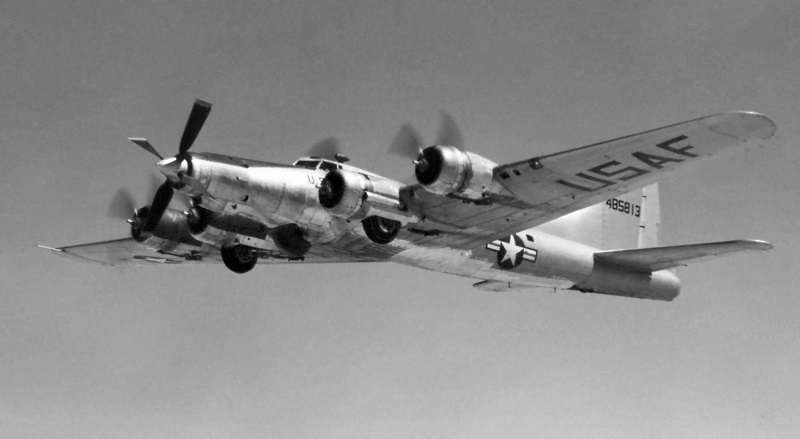
* B-17s were also popular in purely civilian roles after the war. TWA operated one as an executive transport in the immediate postwar years, and many were modified as fire-bombers and pesticide sprayers. One fire-bomber was actually fitted with four Rolls-Royce Dart turboprops in place of the Cyclone radials in 1970, giving it an excess of power, though it had a short career before it was lost in a crash.
The increasing cost of spares and maintenance finally ended the service of the B-17 in these roles in the 1980s, but enough Fortresses survived to make them a reasonably common warbird. Many were restored to their armed configuration, and roughly a dozen are flying. These include the Confederate Air Force's SENTIMENTAL JOURNEY and TEXAS RAIDER, the Lone Star Air Museum's pristine THUNDERBIRD, the EAA's ALUMINUM OVERCAST, and others such as MISS ANGELA, SALLY B, CHUCKIE, NINE-O-NINE, FUDDY DUDDY, SHADY LADY, and MEMPHIS BELLE. While some of these aircraft have the names of famous Fortresses, very few of these survivors actually saw combat. Work continues on restoring more old Fortresses to their wartime glory.
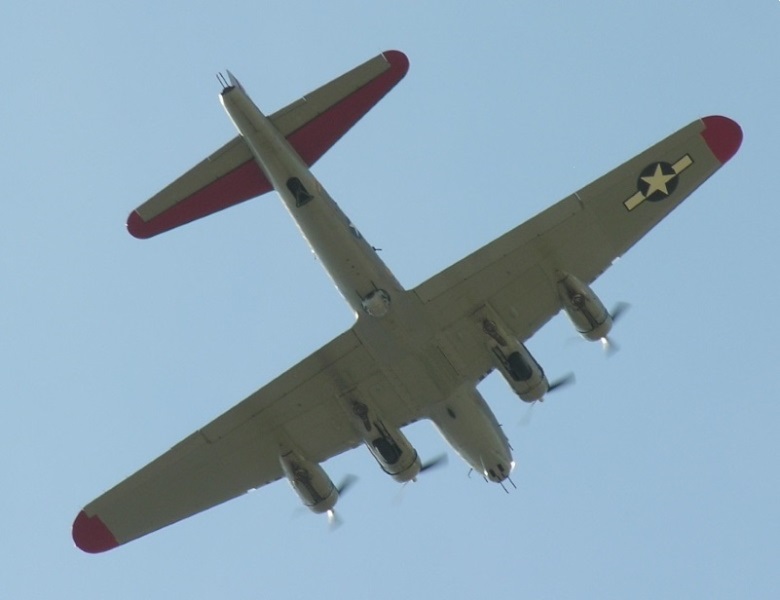
A total of 12,731 B-17s was built in all, variants including:
Fortresses passed on to Britain included 20 B-17Cs as "Fortress I"; 46 B-17Es as "Fortress IIA" AKA "Fortress GR.IIA"; 19 B-17Fs as "Fortress II" AKA "Fortress GR.II"; 14 B-17Fs for electronic warfare as "Fortress II(SD)"; 81 B-17Gs for electronic warfare as "Fortress III(SD); for a total of 180 British Fortresses.
BACK_TO_TOP* While Boeing was working on the Model 299, the company was also considering a four-engine airliner using many of the same design elements as the bomber, with the concept originally designated "Model 300". The effort suffered a setback in 1936, when United and American Airlines decided to work with Douglas to build the four-engine DC-4 airliner, but PanAm and TWA were still interested in the Boeing machine, and in fact PanAm even provided funding to Boeing for development.
The Model 300 design evolved into the "Model 307 Stratoliner", with the first aircraft performing its initial flight on 31 December 1938. The Model 307 could be essentially described as a B-17C mated to a new fuselage, with a streamlined, whale-like shape along the lines of that of the Curtiss C-46 Commando.
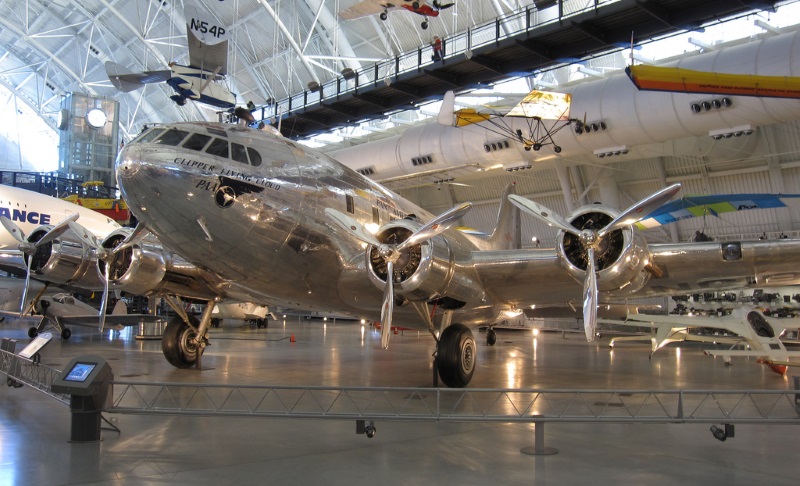
The Stratoliner had a crew of pilot, copilot, flight engineer, and two attendants. It could carry 33 passengers in normal seating, or could be converted to nine reclining seats and 16 sleeper berths. The Model 307 was powered by civil Wright Cyclone GR-1820-G-102 engines, with 820 kW (1,100 HP) each for take-off and driving constant-speed variable propellers. Although the initial Stratoliner was to be delivered to PanAm, it crashed during a flight demonstration on 18 March 1939, with all 13 on board killed. Boeing promptly changed the design to feature a new, taller tailfin, similar to that which would be featured on the B-17E.
___________________________________________________________________
BOEING MODEL 307 STRATOLINER:
___________________________________________________________________
wingspan:
32.61 meters (107 feet)
wing area:
138.05 sq_meters (1,486 sq_feet)
length:
22.66 meters (74 feet 4 inches)
height:
6.34 meters (20 feet 10 inches)
empty weight:
13,610 kilograms (30,000 pounds)
loaded weight:
19,050 kilograms (42,000 pounds)
max speed at altitude:
395 KPH (245 MPH / 215 KT)
service ceiling:
7,985 meters (26,200 feet)
range:
3,845 kilometers (2,390 MI / 2,080 NMI)
___________________________________________________________________
Nine more Stratoliners were built and delivered in 1940. Three were bought by PanAm, with the designation "S-307", and six by TWA, designated "SA-307B". Howard Hughes wanted to buy a Model 307 for a round-the-world flight, but was told he would have to wait until the TWA deliveries were completed. He got around this obstacle by the simple measure of buying TWA and taking control of the first Stratoliner to be delivered to the airline. This aircraft was fitted with extra fuel tanks and P&W R-2600 Twin Wasp engines, receiving the designation "SB-307B", but war intervened and the flight didn't happen.
In December 1941, the TWA Stratoliners were impressed into the USAAF as VIP transports, painted olive drab and given the designation "C-75", though they were actually operated by TWA under military contract. They were returned to civilian service in July 1944 and were upgraded to the "SA-307B-1" configuration, with B-17G wings and tailplane, 895 kW (1,200 HP) Cyclones, and a new electrical system derived from the B-29 Superfortress. Cabin pressurization was deleted and internal partitions were removed to increase accommodation to 38 seats.
Hand-me-down TWA Stratoliners were operated for a time in the postwar period by the French Aigle Azur airline on the Indochina route. Only one Stratoliner survives today. It was refurbished by volunteers at Boeing in Seattle in the early 1990s and is now on display at the Smithsonian National Air & Space Museum's Dulles Airport Annex. The aircraft was ditched in Puget Sound in March 2002 after a fuel-system failure, but it was raised and repaired.
BACK_TO_TOP* Sources include:
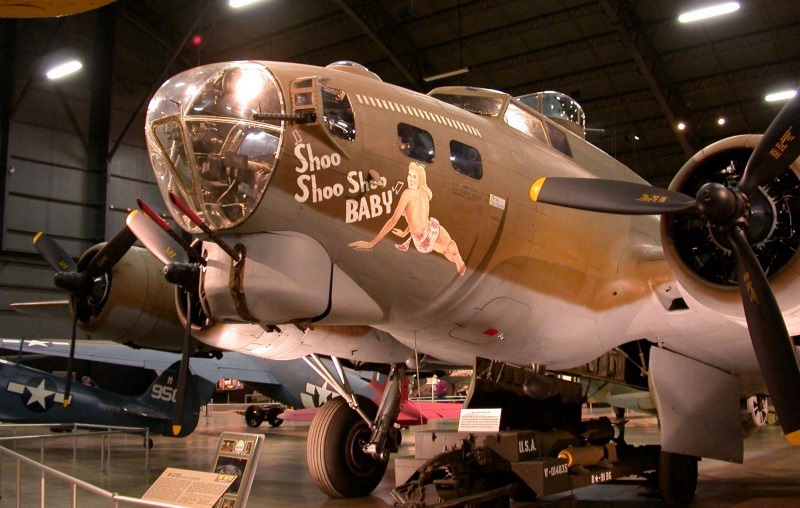
* Illustrations credits:
* Revision history:
v1.0 / 01 jul 99 v1.1.0 / 01 may 02 / Added Model 247 & 307 info, cosmetic changes. v1.1.1 / 01 jul 02 / Added info on B-17 in Soviet service. v1.1.2 / 01 jul 04 / Review & polish. v1.1.3 / 01 aug 05 / Review & polish. v1.1.4 / 01 jul 07 / Review & polish. v1.1.5 / 01 jun 09 / Review & polish. v1.1.6 / 01 apr 11 / Review & polish. v1.1.7 / 01 mar 13 / Review & polish. v1.1.8 / 01 feb 15 / Review & polish. v1.1.9 / 01 jan 17 / Review & polish. v1.2.0 / 01 dec 18 / Review & polish. v1.2.1 / 01 oct 20 / Review & polish. v1.3.0 / 01 apr 22 / Illustrations update. v1.3.1 / 01 mar 24 / Review & polish. (+)BACK_TO_TOP
